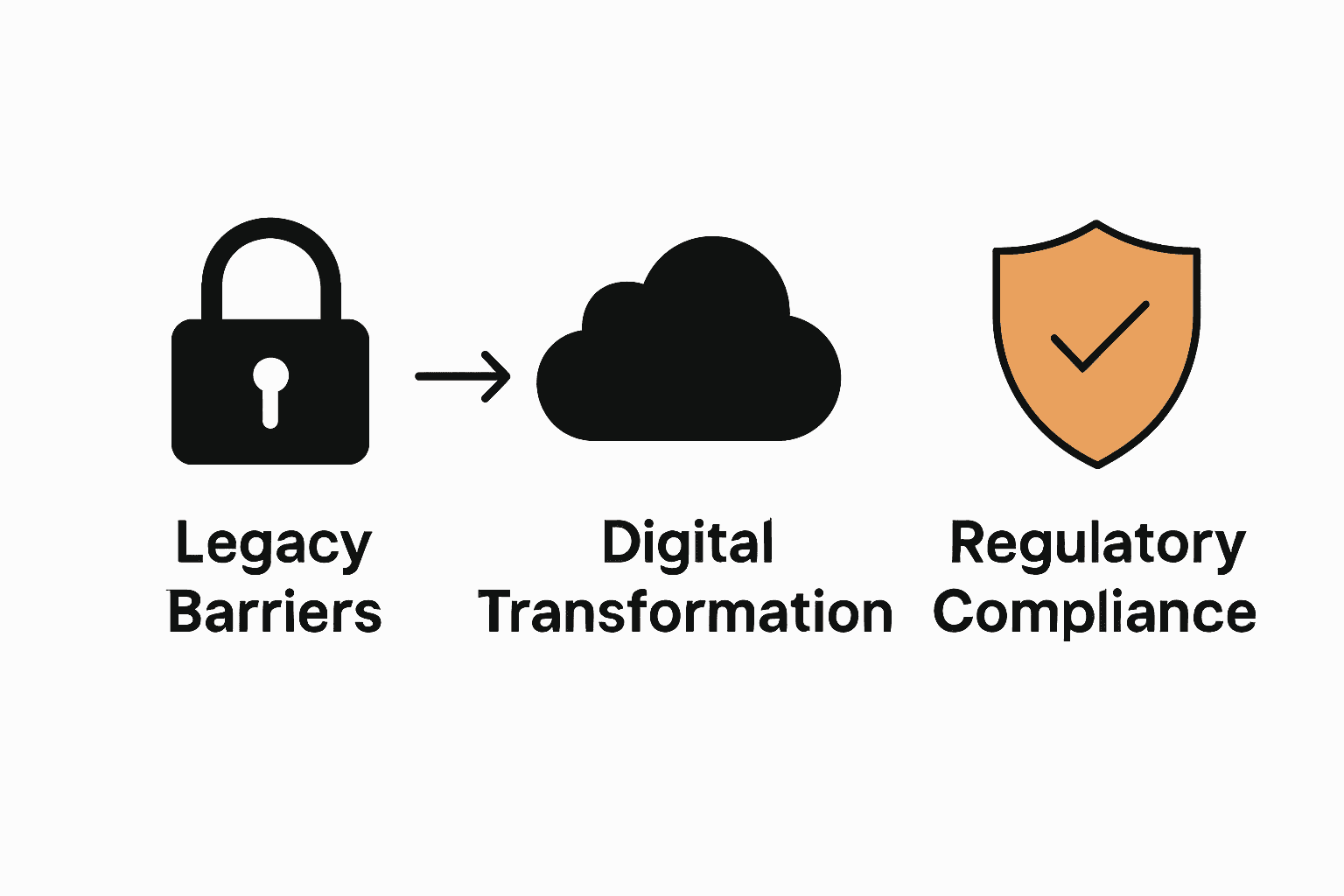Why European Insurers Are Modernizing Core Systems
15.11.25
Why European Insurers Are Modernizing Core Systems

Only one in four insurance digital transformation projects in Europe fully delivers on its promise, despite heavy investment. This stark reality highlights the urgent need for real change within the industry. Legacy technology, complex regulations, and rising customer expectations are all testing the adaptability of insurers. Understanding how to modernize core systems is not just important, it is now a necessary strategy for those determined to remain relevant and competitive.
Table of Contents
- Core System Modernization In European Insurance
- Market Pressures Driving Digital Transformation
- Regulatory Challenges And Compliance Dynamics
- Main Barriers: Legacy Systems And Migration Fears
- How IbSuite Supports Seamless Transformation
Key Takeaways
| Point | Details |
|---|---|
| Digital Transformation is Essential | European insurers must modernize their core systems to remain competitive, driven by technological advancement and evolving customer expectations. |
| Legacy Systems as Barriers | Outdated technology significantly hampers innovation, making strategic modernization essential for operational efficiency. |
| Navigating Regulatory Complexity | Regulatory pressures necessitate adaptive and transparent technological solutions, turning compliance challenges into competitive advantages. |
| Holistic Approaches to Transformation | Successful modernization strategies should encompass technological, organizational, and cultural dimensions, ensuring gradual and controlled system upgrades. |
Core System Modernization in European Insurance
European insurance companies are undergoing a critical digital transformation driven by technological disruption, regulatory pressures, and evolving customer expectations. According to EIOPA, digitalization is fundamentally reshaping insurance product design, development, and distribution across the European market.
The modernization imperative stems from several key strategic drivers. Legacy technology infrastructure is increasingly becoming a significant barrier to innovation, preventing insurers from quickly adapting to market changes. KPMG research reveals a startling statistic: only 25% of insurance transformation initiatives fully achieve their intended goals, despite substantial investments in digitalization projects.
Key challenges in core system modernization include:
- Reducing operational costs
- Integrating emerging technologies like AI and IoT
- Enhancing customer experience
- Maintaining regulatory compliance
- Improving data analytics capabilities
Successful modernization requires a strategic approach that goes beyond simple technology replacement. Insurers must develop comprehensive transformation roadmaps that address technological, organizational, and cultural dimensions. This holistic strategy ensures not just system upgrades, but fundamental operational reinvention that positions European insurers competitively in an increasingly digital marketplace.
By embracing modern, flexible core systems, insurers can unlock significant advantages: faster product launches, improved risk assessment, personalized customer interactions, and more agile responses to market dynamics. The journey of core system modernization is no longer optional—it’s a critical survival strategy in the rapidly evolving insurance landscape.
Market Pressures Driving Digital Transformation
The European insurance industry is experiencing unprecedented transformation driven by complex market pressures. ISG reveals a striking statistic: 75% of insurance leaders recognize that geopolitical tensions, high inflation, and recession threats are rapidly accelerating digital transformation programs.
Economic uncertainty is fundamentally reshaping strategic priorities. Operational resilience has become a critical imperative, with insurers focusing on new customer acquisition, cost optimization, and strategic outsourcing. The survey highlights an urgent reality: 67% of respondents view replacing legacy systems as essential for future readiness and operational efficiency.
Key market pressures compelling digital transformation include:
- Increasing economic volatility
- Rising customer expectations for digital experiences
- Competitive pressures from insurtech disruptors
- Need for real-time data analytics
- Regulatory compliance requirements
Customer behavior is also driving significant change. BCG notes that while only 10% of insurance customers currently complete entire purchasing processes digitally, there’s a clear demand for more sophisticated digital interactions. Insurers must design seamless digital sales journeys that balance technological innovation with personalized customer experiences.
Ultimately, digital transformation is no longer optional—it’s a strategic survival mechanism. By embracing technological innovation, European insurers can build more agile, responsive, and customer-centric business models capable of navigating increasingly complex market landscapes.
Regulatory Challenges and Compliance Dynamics
The European insurance landscape is increasingly complex, with regulatory requirements becoming a critical driver of digital transformation. Dig-In reveals a striking insight: 51% of insurance companies faced financial penalties due to compliance errors, with 70% of executives anticipating increased time dedicated to regulatory compliance.
Regulatory complexity has become a fundamental challenge for insurers seeking to modernize their core systems. The Solvency II Directive has significantly impacted European insurers, demanding more rigorous compliance mechanisms compared to other global markets. This regulatory pressure is pushing organizations to develop more sophisticated, transparent, and adaptable technological infrastructures.
Key regulatory challenges in the insurance sector include:
- Heightened data protection requirements
- Complex financial reporting standards
- Increased transparency mandates
- Evolving cybersecurity regulations
- Stricter consumer protection frameworks
Moreover, EIOPA emphasizes the critical balance between innovation and regulation. The regulatory perspective is not about hindering technological advancement, but ensuring responsible innovation that protects consumer interests and maintains financial system stability. This approach requires insurers to develop flexible technological solutions that can quickly adapt to changing regulatory landscapes.
Ultimately, successful regulatory compliance is no longer about mere adherence, but about transforming regulatory challenges into strategic opportunities. By developing robust, intelligent systems that anticipate and integrate compliance requirements, European insurers can turn regulatory complexity into a competitive advantage.
Main Barriers: Legacy Systems and Migration Fears
Legacy technology remains the most significant obstacle for European insurers pursuing digital transformation. European Financial Review reveals that these outdated systems create siloed environments, dramatically reducing operational efficiency and slowing time-to-market for critical insurance products.
Insurers face profound challenges when contemplating system migration.
 The complexity of existing infrastructure, coupled with deep-rooted organizational fears, creates a formidable barrier to technological modernization. These legacy systems, often built decades ago, are deeply entrenched in core business processes, making replacement a daunting and high-risk endeavor.
The complexity of existing infrastructure, coupled with deep-rooted organizational fears, creates a formidable barrier to technological modernization. These legacy systems, often built decades ago, are deeply entrenched in core business processes, making replacement a daunting and high-risk endeavor.
Key barriers to legacy system transformation include:
- Extensive data migration complexities
- High implementation costs
- Potential operational disruptions
- Skills gaps in modern technological architectures
- Risk of business continuity interruptions
EIOPA emphasizes that successful modernization isn’t about wholesale replacement, but strategic, targeted investments that gradually transform technological capabilities. The most successful insurers are those who approach legacy system modernization as an evolutionary process, incrementally upgrading systems while maintaining operational stability.
Ultimately, migration fears can no longer prevent necessary technological advancement. European insurers must develop comprehensive transformation strategies that balance technological innovation with operational risk management, recognizing that maintaining the status quo is ultimately more dangerous than embracing controlled, strategic change.
How IBSuite Supports Seamless Transformation
Digital transformation in insurance requires more than technological replacement—it demands a holistic approach that addresses complex organizational challenges. IBSuite provides a comprehensive strategy for insurers seeking to modernize their core systems with minimal disruption, offering an API-first, cloud-native platform designed to streamline technological evolution.
The platform’s architecture is specifically engineered to mitigate the primary risks associated with system migration. By enabling incremental upgrades and seamless integrations, IBSuite allows insurers to transform their technological infrastructure without experiencing the typical operational discontinuities that often plague large-scale digital initiatives. This approach transforms migration from a high-stakes event into a controlled, manageable process.
Key transformation capabilities of IBSuite include:
- Evergreen update mechanisms
- Secure, scalable cloud infrastructure
- Comprehensive API integration frameworks
- Modular system design
- Rapid product configuration tools
- Advanced data migration support
Moreover, IBSuite’s platform goes beyond technical capabilities. It addresses the human and organizational dimensions of digital transformation. By providing intuitive interfaces, comprehensive training resources, and flexible implementation strategies, the platform helps insurers overcome cultural resistance and skill gaps that frequently impede technological modernization.
Ultimately, IBSuite represents more than a technological solution—it’s a strategic partner in digital transformation. The platform empowers insurers to embrace innovation incrementally, maintaining operational stability while continuously advancing their technological capabilities. This approach ensures that digital transformation becomes an evolutionary journey rather than a disruptive event.

Unlock Seamless Core System Modernization with IBSuite
European insurers face the daunting challenge of modernizing legacy systems while managing operational risks, regulatory demands, and evolving customer expectations. The article highlights core pain points like complex data migration, high implementation costs, and the fear of disrupting business continuity. IBSuite addresses these challenges by offering a cloud-native, API-first platform built to simplify transformation journeys without sacrificing stability or compliance.
Empower your insurance business to move beyond costly legacy constraints. With IBSuite, benefit from modular design, evergreen updates, and rapid product configuration that enable faster launches and enhanced customer engagement. Take control of your digital transformation with a trusted partner whose platform supports every step from underwriting to claims. Don’t let legacy fears hold you back from the future of insurance.
Ready to turn regulatory complexity and market pressures into competitive advantage? Discover how IBSuite can help you embrace controlled, incremental modernization by booking a personalized demo today. Experience firsthand how IBSuite’s core insurance platform accelerates innovation and operational resilience. Start your transformation journey now with Insurance Business Applications (IBA) and build a future-ready insurance operation.
Frequently Asked Questions
What are the main drivers for core system modernization in the insurance industry?
The key drivers for core system modernization include technological disruption, regulatory pressures, and evolving customer expectations, which require insurers to adapt quickly to market changes.
What challenges do European insurers face during core system modernization?
Insurers face several challenges, including reducing operational costs, integrating emerging technologies, enhancing customer experience, maintaining regulatory compliance, and improving data analytics capabilities.
How does regulatory compliance impact the modernization of core systems?
Regulatory compliance has become a significant challenge for insurers, as it demands sophisticated technological infrastructures. Insurers must develop flexible systems that can adapt to evolving regulations to avoid penalties and ensure consumer protection.
What role does IBSuite play in the transformation of core systems for insurers?
IBSuite offers a holistic approach to digital transformation, providing an API-first, cloud-native platform that allows insurers to modernize their core systems incrementally, minimizing disruption while enhancing operational capabilities.
Recommended
- Why Modernizing Insurance Systems is Crucial for Growth – Digital Insurance Platform | IBSuite Insurance Software | Modern Insurance System
- The benefits of a multi-core strategy for insurers – Digital Insurance Platform | IBSuite Insurance Software | Modern Insurance System
- Why modernize? – Pressure from the market – Digital Insurance Platform | IBSuite Insurance Software | Modern Insurance System
- Core Insurance Systems: What They Are and Why They Matter – Digital Insurance Platform | IBSuite Insurance Software | Modern Insurance System